When most people plan their first trip to Egypt, they usually head to Cairo. The attraction of the ancient treasures and tombs of the Pyramids, the Sphynx, and the Museums provides enough things to do in Cairo. But if you look beyond this sprawling city, other regions are equally as historic and captivating. A day trip to Abu Simbel from Aswan will have you explore one of southern Egypt’s most spectacular temples.
*Disclaimer: This post may contain affiliate links. If you make a purchase through one of these links, I will earn a small commission. This occurs at no added cost to you.*
How to get to Abu Simbel
Taking a day trip to Abu Simbel will require you to decide how quickly you want to get there. There are two ways to get there, and the first is to fly. From Aswan, Egypt Air makes several flights a day to Abu Simbel. The flight takes about 45 minutes and costs about USD 150. Check with your favorite flight search engine like Cheap-O-Air for the current prices.
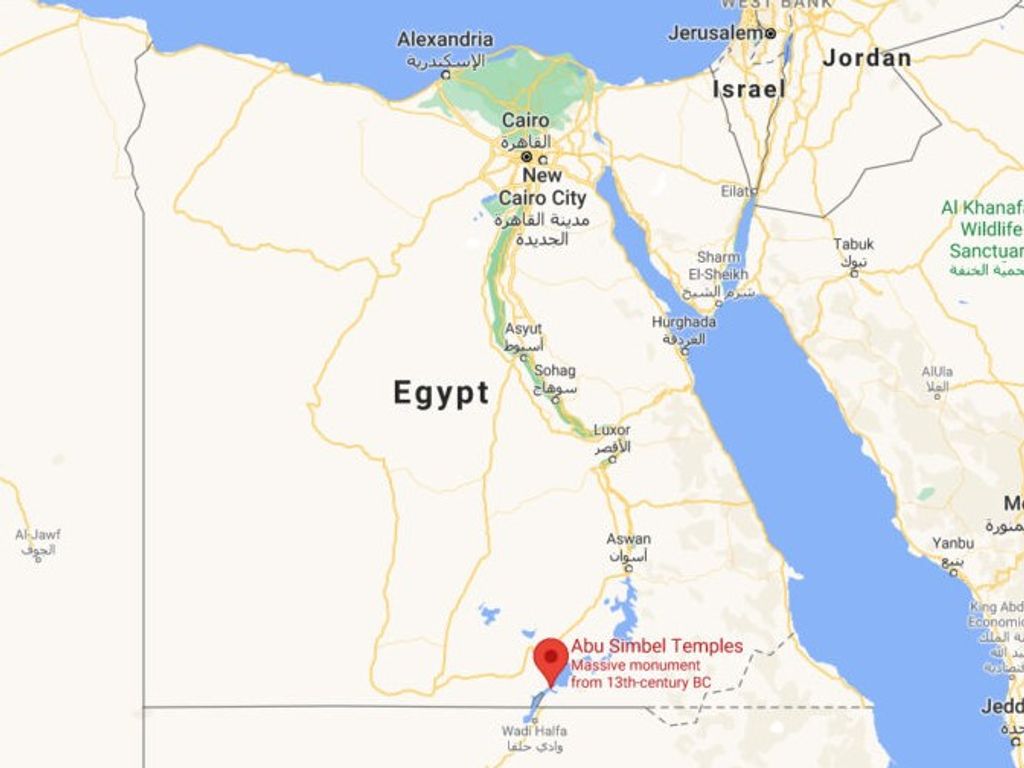
The second option for getting to Abu Simbel is to take a bus. This is the most common method, although it takes a lot of time. The distance is about 289 kilometers and takes about 3.5 to 4 hours. This is the way to go if you want to experience a journey and travel through the desert. There are many options available through booking sites like the Trip to Abu Simbel Temple from Viator or the Abu Simbel Temples by Bus or Private Car from Get your Guide; if the trip is not part of another organized tour, you may have booked. Let me describe the trip before you make your decision about which method to take.
Whether you get on the bus at your hotel or your Nile cruise boat, you will be up early in the morning. Typically, the bus picks up passengers bright, and early around 3:30 am. It is likely that you have received your first cup of coffee, but perhaps you would rather skip the coffee and sleep on the bus instead. The choice is up to you.
In order to reach Abu Simbel, you must pass through a security checkpoint on the outskirts of Aswan. You may find that an armed guard is on board your tour bus if you are passing through the checkpoints with a licensed tour operator or private guide. They are part of the Tourist Police, which is a routine precaution.
RELATED: Need to keep track of the temples visited on the Nile cruise? Get the Nile Cruise Temple Tracker available on Etsy.
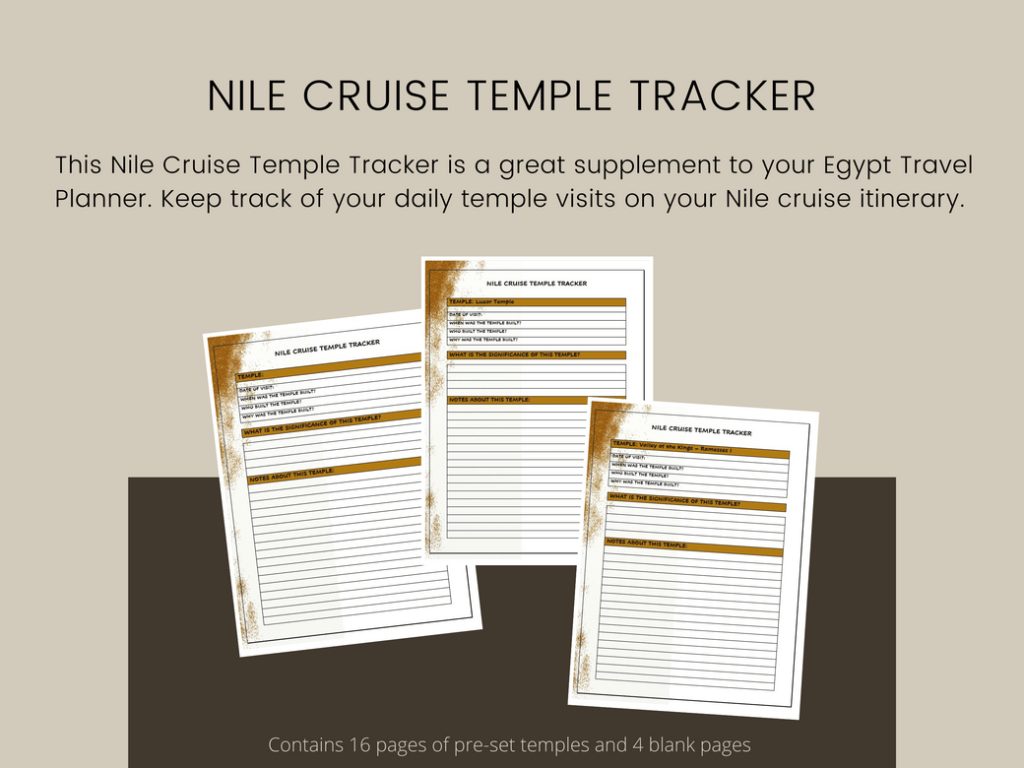
There is not much to see along the road, and it isn’t exciting. Some people bring a pillow to pass the time by catching up on some sleep. It seems silly to sleep while traveling through a completely different part of Egypt, especially one that forms part of the Sahara Desert! If it is a scorching day for your trip, you may see a mirage either on the way to Abu Simbel or back.
You may see full-size buses passing yours on this road since buses tend to race one another.
Upon arrival at Abu Simbel, you will first see the “mountain,” the back of the temple with Lake Nasser in the background. It is a beautiful location.
Once you walk the path and go around the bend, you can’t miss the four colossal statues. This is why you took this day trip to Abu Simbel!
No amount of picture or video research can prepare you for the immense size and significance of these colossal statues that enhance the entrance to this temple.

What is Abu Simbel?
Abu Simbel is an archaeological site that hosts a series of incredible ancient Egyptian monuments. The two rock temples of Ramesses II are the largest and most famous sites. Near the Sudanese border, in a region known as Nubia, these temples in southern Egypt are just 25 miles (40 km) away.
Pharaoh Ramesses II and his queen Nefertari built these temples in the 13th century BC as a lasting monument. The great deities of ancient Egypt, Ptah, Amun-Re, and Ra-Horakhti (Ra), were also celebrated in this temple. Ptah was the craftsmen god of Memphis, Amun-Re, the head of the Triad of Thebes, and Ra-Horakhti (Ra) was the Sun God and head of the Ennead of Heliopolis. Egyptians believed that Ra was the world’s creator, representing sunlight, warmth, and growth.
Next to these three, the statue of Ramesses is represented as the fourth great god of Egypt. Ramesses built the temples to immortalize himself as he believed that he, too, was a god. Ramesses chose this site because it was already sacred to Hathor, the goddess of motherhood, joy, and love. He believed that Nefertari possessed similar qualities to Hathor. Hathor was also revered as someone who oversaw welcoming the dead as they passed into the spiritual world.
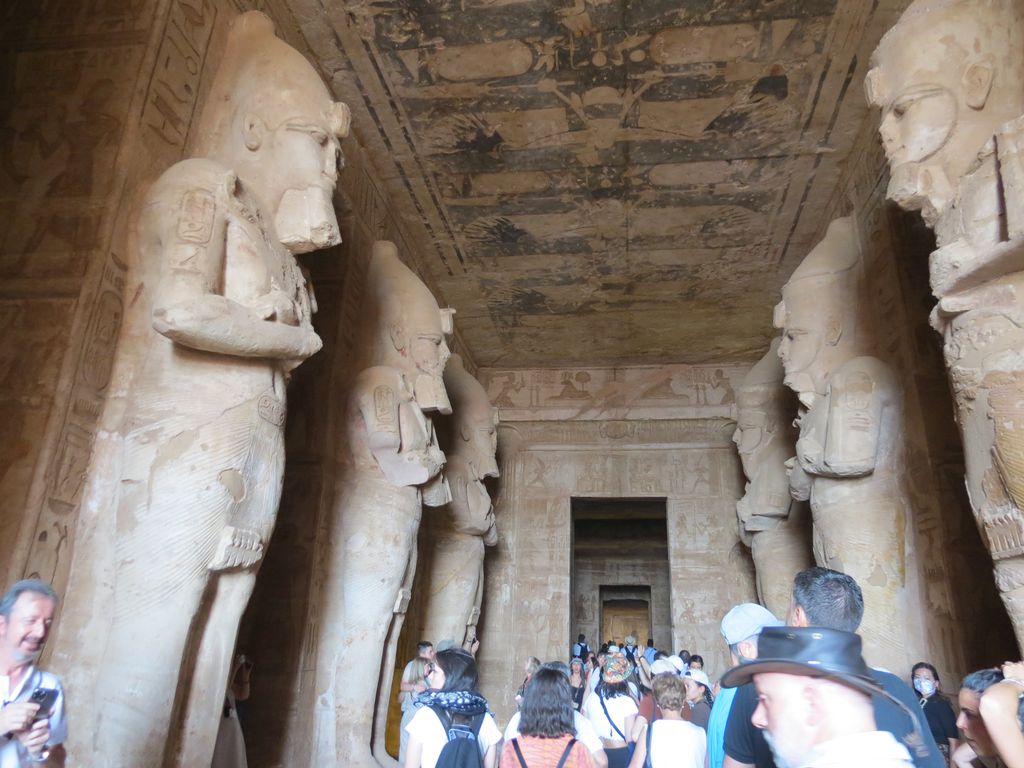
Construction of the temple was completed around 1244 BC, but like many ancient installations in Egypt, it became entombed in the unrelenting sands of time. By the 6th century BC, the statues were covered to the knees. It has been told through the years that the temple was re-discovered by a boy named Abu Simbel, who led a Swiss explorer (Jean-Louis Burckhardt) to the site in 1813. As a result of the find, the site and temple were named after the boy. When you take a day trip to Abu Simbel, your Egypt tour guide will explain more of the site’s history.
Note: In order to alleviate the crowds at the temple’s entrance, tour guides are not permitted inside. Your guide will explain the history is the perimeter grounds and gives you insight into some of the markings to look for while inside. Be sure to wear a hat or sun umbrella as there is no shade in this area and it is very HOT all the time.
Unlike other temples in Egypt, these temples were carved directly into the sandstone outcrops located on the west bank of the Nile River. The larger one, known as the Great Temple, honored Ptah, Amun-Re, Ramesses, and Ra-Horakhti, while the smaller one honored Hathor and Nefertari, Ramesses’ favorite wife.
The Great Temple
Four massive, seated pharaoh sculptures represent Ramesses II at different ages adorn the entrance to Abu Simbel’s Great temple. Beneath these gigantic figures are smaller statues depicting Ramesses’ enemies – the Nubians, Libyans, and Hittites. It is hard to imagine the size of these structures, and the pictures do not do them justice!

Once inside the Great Temple (also known as the Sun Temple of Ramses II), you are greeted with two rows of statues of Ramses, each 30 feet high. This is known as Osiris hall. The sculptures on the north side wear the white crown of Upper Egypt, while those on the south side wear the double crown of Lower Egypt. Ramesses believed he was the ruler of both.
This hall is designed and precisely cut so that twice a year, the sun rays shine down the entire length to light up the back wall where the statues of the four gods (Ptah, Amun-Re, Ramesses, Ra-Horakhti (Ra)) are seated. It is a real work of engineering to have such precision and incredible skill during that time.
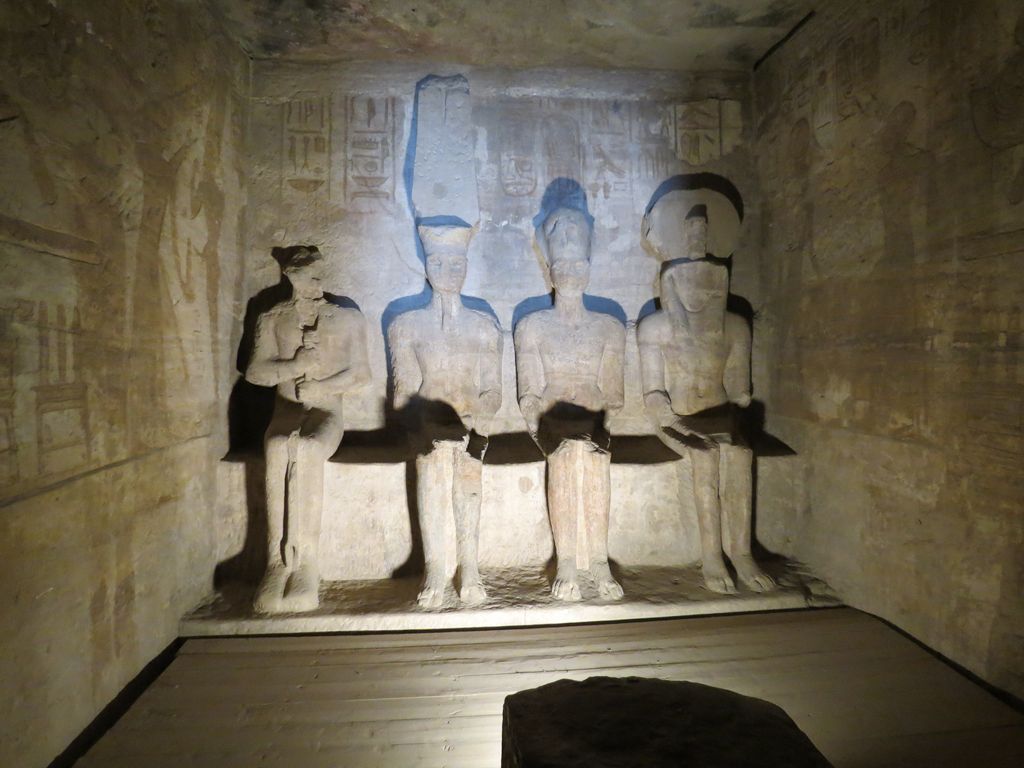
Adjacent to the great hall is several chambers where smaller statues and hieroglyphics adorn the walls. They tell the stories, legends, and beliefs of the kings and pharaohs passed down through the centuries. It is hard to believe that these temples were created so long ago, as many of the carved images show slight deterioration inside the temple.
Nefertari Temple
The Temple located just north of the main temple is dedicated to the goddess Hathor or, more accurately, to Ramesses’ favorite wife, Nefertari, in the form of Hathor. This temple, also called the Temple of Hathor, is adorned with six statues, four of Ramesses II and two of Nefertari. It was unusual for an Egyptian king to honor his wife this way, but since Ramesses thought so highly of himself, it was not surprising.
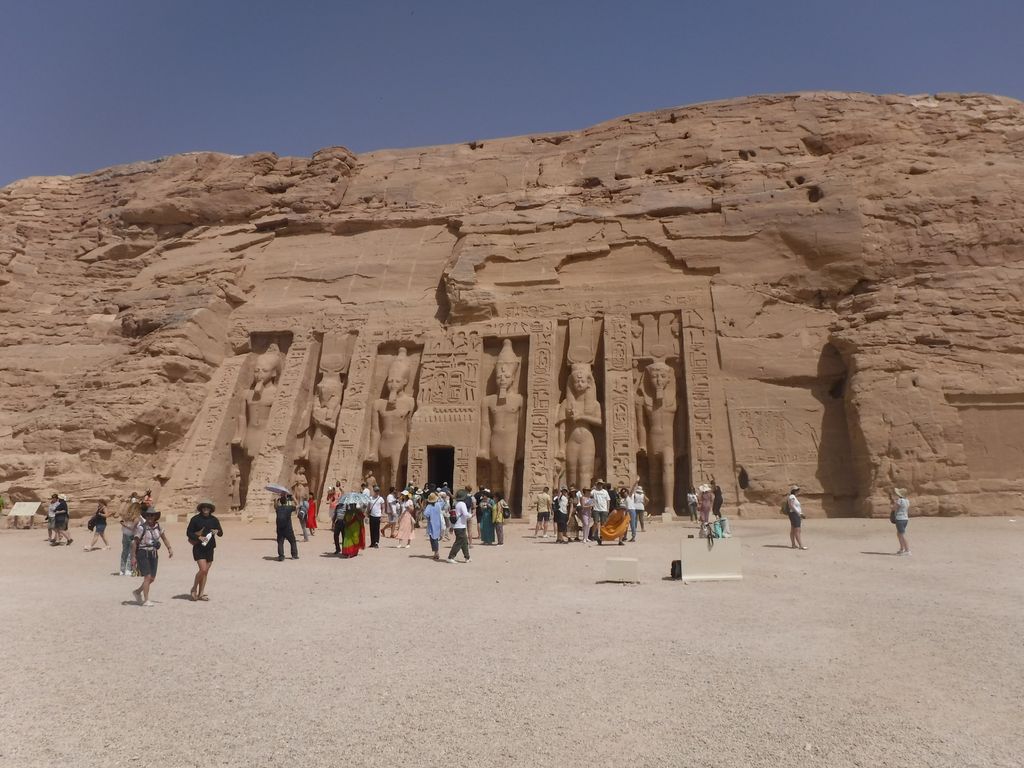
Once inside, the pillared hall is surrounded by art and carvings similar to those in the Great Temple. The East Room contains scenes showing Ramesses and his wife, Nefertari, offering sacrifices to the gods.
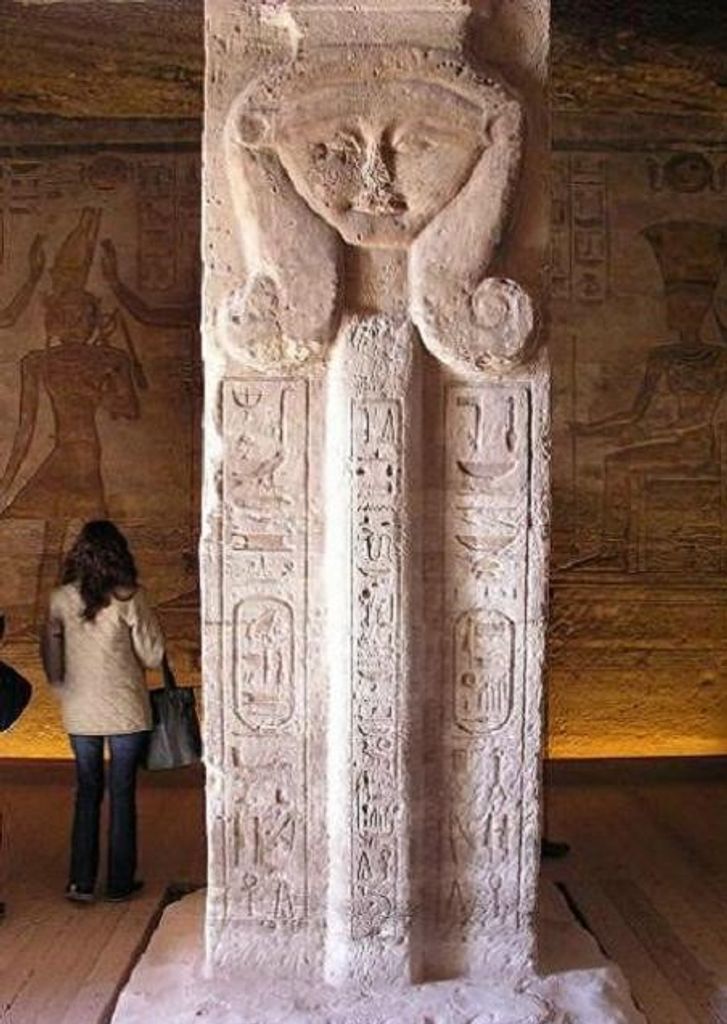
Temple of Abu Simbel Relocation
Now that you are impressed with the size and history of the temple, were you aware that this temple was relocated? Yes, you read that correctly. The temple and its surrounding mountain were relocated!
In 1960, the Egyptian government planned to build the Aswan high dam on the Nile River, but the construction threatened to flood the Abu Simbel temple site. Knowing this temple’s importance to the Egyptian people, the government devised a plan to move the temples to a safe distance from the rising water.
The government asked the United Nations for assistance designing and relocating the temples, and 51 countries supported this project. Over four years between 1964 and 1968, both temples were strategically dismantled and reassembled on a higher rock plateau some 200 feet (65m) up the riverbank and 600 feet (180m) to the west.

For nine months, day and night, the temple was cut into 1050 large blocks weighing around 30 tons. The incisions had to be precise to minimize damage to the temple. The biggest challenge in this endeavor was that the great temple must be aligned so that the sun’s rays shine again through the entrance to the gods’ faces inside.
On your day trip to Abu Simbel, you will have undoubtedly noticed the mountain surrounding the temple. This is a substantial artificial dome erected over the temple. Consisting of 300 interconnecting concrete sections, this dome was covered with smaller imitation rocks to give it a realistic look. At first glance of the mountain and the temple, you would see nothing amiss, but if you look closely, you can find cut lines and identification markers for each piece.
From an engineering point of view, this application of design and calculations is one of the most incredible achievements undertaken at that time. Even today, it is remarkable to think that technology was available to MOVE a mountain physically!
Final Thoughts
Today, the two temples of Abu Simbel represent the glory and grandeur of ancient Egypt. They are impressive not only by their size but also by their genius in engineering. Aside from the pyramids, these temples are a must-see attraction for anyone who seeks to explore the history of Egyptian civilization.
Are you planning a trip to Egypt?
Will Abu Simbel be on your list of day trips?
8 Things to Know About Visiting Abu Simbel
- Is it safe to visit?
Despite the heavy police presence, or perhaps because of it, the day trip to Abu Simbel is very safe. When your bus arrives to pick you up, it will most likely have a guard already on the bus. You may also notice a second bus driver as a backup as the day is long. You will stop at the first checkpoint as you head out of town. The guards will verify with the driver that the bus contains tourists and that the tour guide is registered. You are not required to present any passport or any other identification. This is just a method of controlling access to the highway.
There are a few other checkpoints along the way, but each only takes a minute to pass through.
- Do You Need a Guide?
This is a bit of a complicated question. Technically, if you are coming from Aswan, you will either be a part of an organized tour with a guide, or you will have a private taxi driver who acts as your guide and converse with the police/guards. During the journey, your guide or driver will be able to provide you with a bit of the history of Abu Simbel and the history of Egypt. They may also share pointers about what to pay attention to while visiting Abu Simbel Temple Complex.
Or, if you choose to fly, you can take a taxi from the airport and be at Abu Simbel in about 15 minutes. In this case, you will not have a guide, and the choice is up to you.
So, the question is, do you need a guide? Although guiding is not permitted inside the Abu Simbel temples, they can stand outside and give you all the information and stories about the temples. To truly appreciate and understand the importance and significance of these temples, I would strongly recommend having a guide. Without direction or suggestions on what to look for, you may miss some of the essential elements of the temple. A knowledgeable guide is priceless!
Related: Ultimate EGYPT Trip Planning Checklist Bundle available on Etsy.

- What are the Opening Hours?
The Abu Simbel temple Complex is usually open daily, 8 am – 10 pm.
If you are staying in Abu Simbel, check out the sound and Light show in the evening.
The current pricing for the Temple Complex is as follows:
FOREIGNERS:
Adult: EGP 260/ Student: EGP 130
February 22nd & October 22nd:
Adult: EGP 500/ Student: EGP 250
EGYPTIANS/ ARABS:
Adult: EGP 30/ Student: EGP 10
February 22nd & October 22nd:
Adult: EGP 60/ Student: EGP 20
- Is there a Sound and Light Show?
Yes, there is a Sound and Light show at Abu Simbel. This show provides a journey back to the pharaohs’ era, bringing it back to life. The enchanting music and vibrant lights will accompany you on this journey. The show depicts this temple’s appearance, along with its distinguished history.
Needless to say, the temples are stunning when lit up in the evenings!
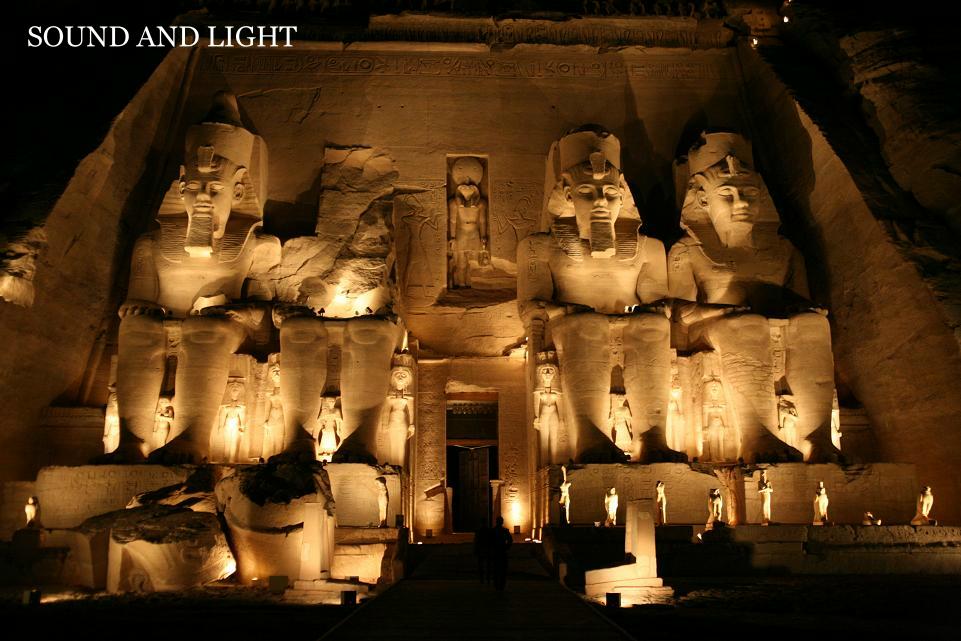
Be aware that the need to have a minimum of 10 people for it to take place. You can check ticket prices and availability on the Sound and Light Show website.
- Is Abu Simbel Accessible for those with Mobility Issues?
Like most ancient Egyptian temples, tombs, and pyramids, wheelchairs are usually not capable of going inside the attractions. There are stairs, and there is a rather large visitor’s center in larger centers like the Pyramids of Giza or the Valley of the Kings. In these air-conditioned centers, a wheelchair can go inside to view the presentations, models, and displays.
For other types of mobility issues requiring canes and walkers, you should be aware that there are MANY stairs in most tourist attractions. Some of the stone’s steps are in good condition, but many are in poor condition and narrow, uneven, and very steep. Handrails are also not present in every location. At the complex at Abu Simbel, there is a paved pathway around the side of the mountain to the front of the temple, and golf carts are available to transport people if required.
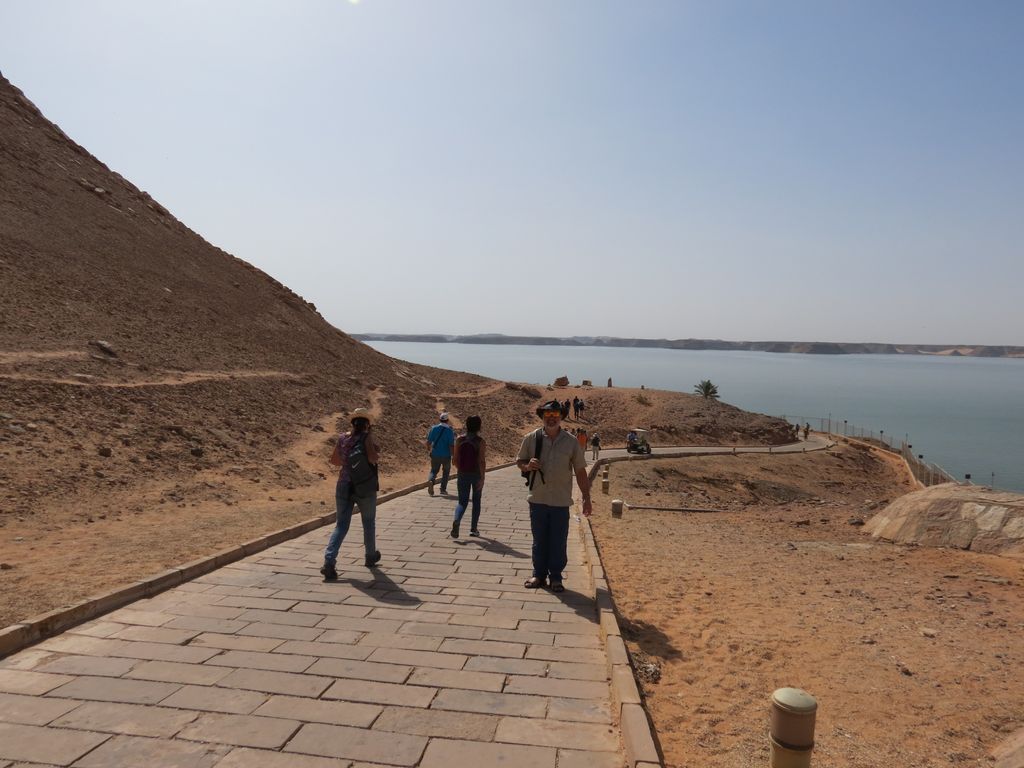
- Will it be HOT!
YES! It will be sweltering even in the winter since Abu Simbel is near the border with Sudan, which lies close to the equator. Wear sunscreen, a hat, sunglasses, and comfortable walking shoes. Be sure to keep hydrated as well. It is best to bring your water, as none is available until you are on the way out. You should also know that there is almost no shade and few places to sit. A sun umbrella is always a good option under these conditions.
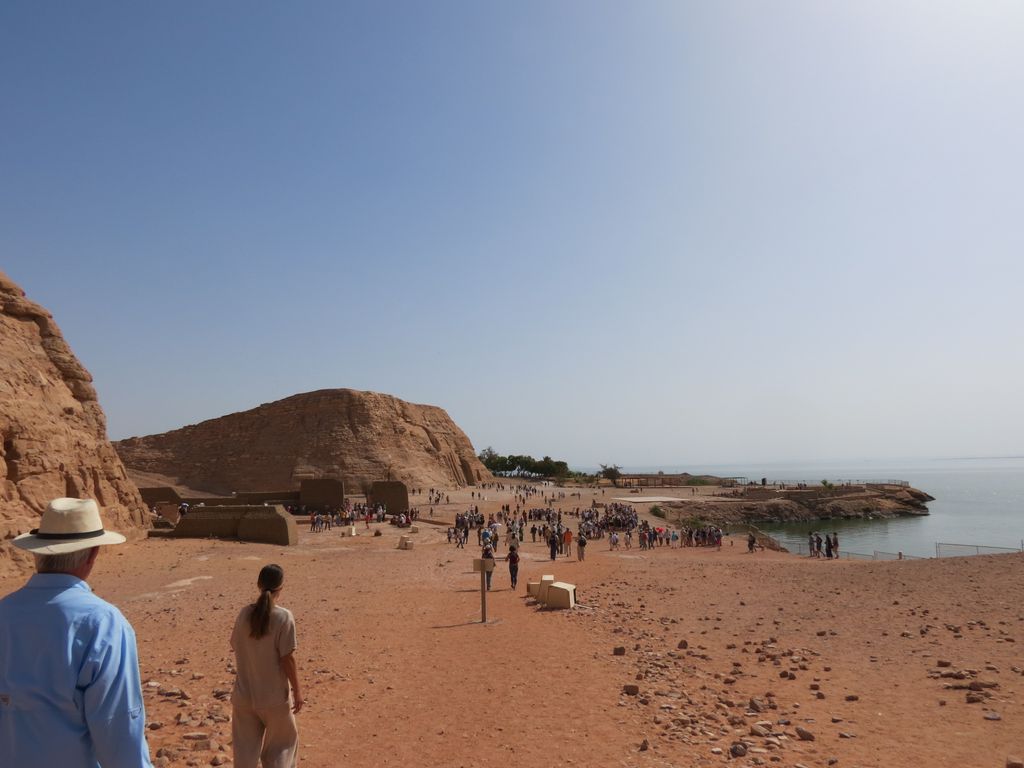
- Are there souvenirs?
Like most tourist attractions in Egypt and elsewhere, there is always something to buy on your way out. At Abu Simbel, there is a market with local vendors trying to peddle their wares. Like other markets in Egypt, the sellers tend to be aggressive, and they will try to sell you books, postcards, scarves, and maps of the Nile. Remember to haggle and be careful of your things.
- What to wear at Abu Simbel?
As I have mentioned, Abu Simbel is hot! In fact, for most of the year, anywhere you go in Egypt will be hot. It is generally a good idea to wear loose-fitting, breathable clothing in these hot climates. In Egypt, you should also consider conservative clothing that covers you to respect the culture. Capris are acceptable, but shorts, short skirts, and revealing clothes are a big no, no.
As Abu Simbel is a tourist site, it is not uncommon to see various forms of Western dress and culture, but if you stay in the town, a more conservation wardrobe would be better. As mentioned, a sunhat and perhaps a scarf to protect from heat and potential sandstorms. Comfortable walking shoes are a must as the surfaces at the temple complex can be uneven.
I hope I have given you some insight into why a day trip to Abu Simbel is so special and is one of the greatest temples near Aswan.
Related posts on Egypt:
How To Plan Your First Trip To Egypt
Outstanding Things You Need to See in Cairo
Luxor Balloon Flight – Is It Really Worth the Hype?
Top 8 Egypt Travel Tips You Should Know
10 Reasons Why a Day Tour to Alexandria from Cairo is Worth It
Like this post? Pin for Later.


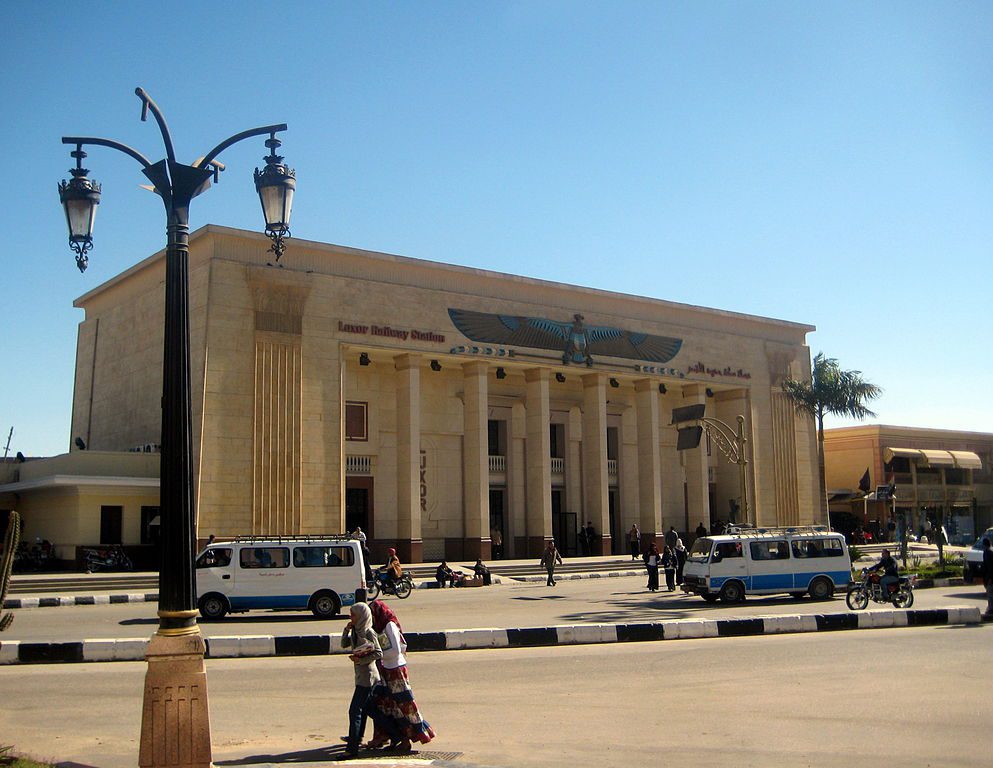


Traveling to Egypt sounds so exotic! I would love to take this day trip to Abu Simbel from Aswan and explore these spectacular temples.
Everything Egypt continues to boggle my mind! The history and architecture are so incredible. And then to learn this was relocated! Just wow! Thank you for sharing!
Super thorough post. There are some great documentaries on youtube about how they moved the temple – it’s intense!
Thanks for sharing another wonderful post on Egypt 😉 I have been thinking about doing something like this as well for awhile now as I am greatly intrigued by Egypt’s history and its architecture. What a feat of engineering that is. I think if there’s an Egyptian curse, it must be the need to go there #flyingbaguette
Fascinating post, the temple certainly looks good. Your Egyptian series certainly is causing Egyptlust.
Abu Simbel was one of my highlights of Egypt and to think it could have been lost if it hadn’t been relocated! I don’t remember it being so crowded when I was there but I’ll never forget the heat!!
It’s so impressive to think that this was relocated. It’s even crazier to think it could have disappeared under the water had they not succeeded. I was just wondering if there was any kind of armed presence when you mentioned that. Did you feel nervous at all? It’s a shame we have to consider things like this in some places…